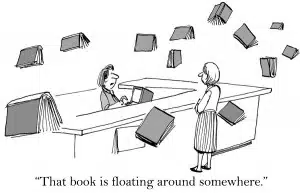In the beginning, the world was void – formless, nameless, unreadable. Then everything got categorized, and we’ve been trying to file it ever since. It makes sense, doesn’t it?
So too with books. Just as soon as an author writes something, somebody comes along and categorizes it. The most successful authors categorize their work first, then write it.
When you have information, you need to put it somewhere. You’ve got to be able to access it again, and other people will probably want to look at it too. Thus was born the BISAC, the Publishing industry’s answer to the Dewey Decimal system.
The BISAC is a list of hundreds of categories and sub-categories that has rapidly becoming the industry standard for classifying books by genre. There are those who argue that in time it will replace the venerable Dewey Decimal System. Others contend that it already has.
If you’re a published author – or would like to be – it pays to educate yourself on the technicalities of book publishing. You only need to be a little bit more savvy than the rest of the pack in order to be miles ahead, perhaps even capture that elusive best-seller status.
Let’s take a look at how choosing the right category can help you sell more books.
Dewey or Don’t We?
The Dewey Decimal System is most commonly associated with stern-faced librarians and dusty book covers. I can remember volunteering at the Arbor Heights Grade School library as a kid, hoisting abandoned volumes into gaps on the shelves, putting away the day’s reading material while Miss Marian looked on from behind her half-glasses while adjusting her bun.
It was kind of fun. I could sort and organize, while enjoying the smell of ink and leather that when combined makes that “library smell.” Come on, you know what I mean! The fact that I grew up to be a publisher is amusing to my high-tech executive sensibilities – but then, certain advances in publishing technology have helped take the toil out of hocking Tolstoy and his modern-day equivalents.
This leads us back to the BISAC, more formally known as the Book Industry Standards and Communications list. What I’ve found in working with authors is that very few of them have ever heard of the BISAC. Little do they know how essential this tool is for their publishing success!
Unless you’re writing for your own amusement, we can make the argument that your book needs to fit into an established genre. People need to find it, and book sellers need to be able to organize War and Peace next to your masterpiece.
Many would argue that the Dewey Decimal system does this, but that does little for the author when it comes to selling books at retail. This archaic system is too confusing, and it takes an entire course of study in Library Science to learn to speak Dewey.
ISBN for Ibsen, BISAC for the Basics
The ISBN (International Standards Book Number) is a numeric commercial book identifier based on a 13-digit code (generally), and it serves as the anchor for your book’s bar code. Retailers and e-tailers need to have one for your book in order to sell it – even if your name is Henrik Ibsen and you’ve won the Nobel Prize for Literature.
But the ISBN doesn’t do anything to help customers find your cherished volume. It’s for machines only – not at all user-friendly. The Dewey Decimal System is the next best thing, but it still doesn’t quite fit the bill.
Way back in 2007, there was a flap in the news about a public library in Texas doing away with the Dewey Decimal System altogether and organizing their catalog like a bookstore would. The nerve! Imagine helping people find what they’re looking for in an easy-to-understand way. What system did they use? The BISAC.
The BISAC is the brainchild of the Book Industry Study Group, and their list itself is copyrighted material. But just about every bookseller in the world refers to it now. I predict that it won’t take long for libraries to catch up. You can find the BISAC master list on the BISAC website: https://www.bisg.org/complete-bisac-subject-headings-2014-edition
At the core of every book is a sense of relativity – where your book fits into the grand scheme of things. As you set about to draft, polish and market your magnum opus, ask yourself these questions:
- Who else has written a book like yours?
- Why is their book successful?
- Who will want to read your book?
- What is the single most relevant category for your book?
- What is the most appropriate BISAC genre for your book?
Some authors don’t like to be pinned down to a single category as they write. What they don’t realize is that they’re doing themselves a disservice by ignoring genre requirements. Books aren’t supposed to be elusive. Even books on cryptozoology are easy to find with BISACs.
When you sit down to write, try to think like a book seller. Choose a BISAC that matches your material. With a little discipline and forethought, your manuscript will serve more people with less effort.
In the end, you’ll actually sell more books. Now that’s a category any author can live with – the best-seller category.


